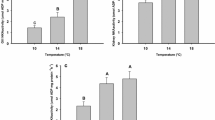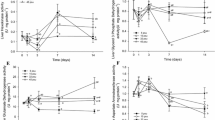Abstract
We hypothesize that the morpho-physiological adaptations that permit tunas to achieve maximum metabolic rates (MMR) that are more than double those of other active fishes should result in high water and ion flux rates across the gills and concomitant high osmoregulatory costs. The high standard metabolic rates (SMR) of tunas and dolphin fish may, therefore, be due to the elevated rates of energy expenditure for osmoregulation (i.e. teleosts capable of achieving exceptionally high MMR necessarily have SMR). Previous investigators have suggested a link between activity patterns and osmoregulatory costs based on Na+-K+ ATPase activity in the gills of active epipelagic and sluggish deep-sea fishes. Based on these observations, we conclude that high-energy-demand fishes (i.e. tunas and dolphin fish) should have exceptionally elevated gill and intestinal Na+-K+ ATPase activity reflecting their elevated rates of salt and water transfer. To test this idea and estimate osmoregulatory costs, we measured Na+-K+ ATPase activity (V max) in homogenates of frozen samples taken from the gills and intestines of skipjack and yellowfin tunas, and the gills of dolphin fish. As a check of our procedures, we made similar measurements using tissues from hybrid red tilapia (Oreochromis mossambicus ×O. niloticus). Contrary to our supposition, we found no difference in Na+-K+ ATPase activity per unit mass of gill or intestine in these four species. We estimate the cost of osmoregulation to be at most 9% and 13% of the SMR in skipjack tuna and yellowfin tuna, respectively. Our results, therefore, do not support either of our original suppositions, and the cause(s) underlying the high SMR of tunas and dolphin fish remain unexplained.
Similar content being viewed by others
Author information
Authors and Affiliations
Additional information
Received: 7 September 2000 / Accepted: 4 December 2000
Rights and permissions
About this article
Cite this article
Brill, R., Swimmer, Y., Taxboel, C. et al. Gill and intestinal Na+-K+ ATPase activity, and estimated maximal osmoregulatory costs, in three high-energy-demand teleosts: yellowfin tuna (Thunnus albacares), skipjack tuna (Katsuwonus pelamis), and dolphin fish (Coryphaena hippurus). Marine Biology 138, 935–944 (2001). https://doi.org/10.1007/s002270000514
Issue Date:
DOI: https://doi.org/10.1007/s002270000514




